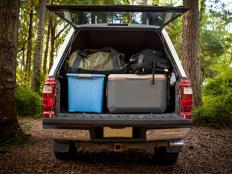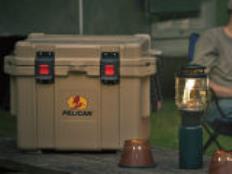Windows
If you don't have dual pane windows, you may be able to retrofit with insulated RV windows. Or, you can add insulated curtains. Keep them closed at night to trap in warm air. For a Class A or Class C motorhome, an insulated curtain made to separate the cockpit from the living area will reduce the amount of cabin space you need to heat, saving propane or electricity.
A low-cost solution is to cover your windows on the inside with foil-backed foam insulation, available at most home improvement stores. Lightweight and easy to cut, you can attach hook-and-loop fasteners to the window frame and the insulation to hold them in place. Also available is a window insulating film that reportedly reduces condensation and stops heat loss.
Ceiling Vents
Most RVs have roof vents or skylights, ideal places for heat to leak out. Seal off these spots by installing RV vent cushions, which fit securely into most standard-size vents simply by pushing them up into position. If you're handy, you can also make custom-size vent cushions out of thick foam padding, available at home improvement or fabric stores.
Stabilizing Jacks
Stabilizing jacks can freeze to paved or concrete pads, so place blocks of wood beneath them. This way, you can raise the jacks, drive forward, and then free the blocks with ice melt, a hammer and a chisel. Or, just leave the blocks and get replacements later.
Refrigerator
The refrigerant in a propane or electric refrigerator is a solution of hydrogen gas, ammonia, distilled water and sodium carbonate, all under 200 PSI pressure. When outside temperatures drop below 20 degrees Fahrenheit, this liquid may turn to a gel that can plug the refrigeration system's coils permanently.
To help avoid this, remove the outside refrigerator access cover and apply duct tape over the top two out of three vent slots. Do this on the inside of the cover to prevent leaving adhesive on the outside when removing the tape. An easier alternative is to insert round half-inch pipe insulation in the top two slots from the outside.
In extremely cold weather, it may be necessary to place a small space heater in the compartment, set on low. Make sure that the heater is not near any flammable surfaces.
Ice Maker
Many RV builders do not insulate or heat the ice maker water line. If this is your situation either drain the water line, insulate it, or wrap it with heater tape.
Furnace
Test the furnace before you hit the road. Clean the furnace area using compressed air or a soft brush to remove all dust, debris and insects. If your RV has only a heat pump or heat fins, consider an additional heat source as these systems don't work well when the outside temperature drops below 40 degrees Fahrenheit.
If you don't want to run the furnace, portable electric space heaters can make a real difference in staying warm, as can a catalytic heater--just be sure that a window or vent is open a crack for ventilation.
And be aware that interior heat and moisture from your breath and a catalytic heater can create condensation in your RV. An electric dehumidifier, if you're plugged in, or a container of moisture absorbent will remove dampness from the air and help prevent corrosion, mold and mildew.
Propane
If you use propane to heat your rig, it's likely to last only a few days in really cold weather. Make sure that a propane refill station is nearby and open, or bring a couple of extra tanks with you, safely secured for travel.
Some campgrounds offer propane bottles for rent. Call ahead to find out.
- 2
- of
- 3








Discuss This Article